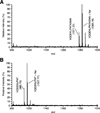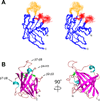Solution structure of the sortase required for efficient production of infectious Bacillus anthracis spores
- PMID: 22974341
- PMCID: PMC3971844
- DOI: 10.1021/bi300867t
Solution structure of the sortase required for efficient production of infectious Bacillus anthracis spores
Abstract
Bacillus anthracis forms metabolically dormant endospores that upon germination can cause lethal anthrax disease in humans. Efficient sporulation requires the activity of the SrtC sortase (BaSrtC), a cysteine transpeptidase that covalently attaches the BasH and BasI proteins to the peptidoglycan of the forespore and predivisional cell, respectively. To gain insight into the molecular basis of protein display, we used nuclear magnetic resonance to determine the structure and backbone dynamics of the catalytic domain of BaSrtC (residues Ser(56)-Lys(198)). The backbone and heavy atom coordinates of structurally ordered amino acids have coordinate precision of 0.42 ± 0.07 and 0.82 ± 0.05 Å, respectively. BaSrtC(Δ55) adopts an eight-stranded β-barrel fold that contains two short helices positioned on opposite sides of the protein. Surprisingly, the protein dimerizes and contains an extensive, structurally disordered surface that is positioned adjacent to the active site. The surface is formed by two loops (β2-β3 and β4-H1 loops) that surround the active site histidine, suggesting that they may play a key role in associating BaSrtC with its lipid II substrate. BaSrtC anchors proteins bearing a noncanonical LPNTA sorting signal. Modeling studies suggest that the enzyme recognizes this substrate using a rigid binding pocket and reveals the presence of a conserved subsite for the signal. This first structure of a class D member of the sortase superfamily unveils class-specific features that may facilitate ongoing efforts to discover sortase inhibitors for the treatment of bacterial infections.
Figures






Similar articles
-
Targeting proteins to the cell wall of sporulating Bacillus anthracis.Mol Microbiol. 2006 Dec;62(5):1402-17. doi: 10.1111/j.1365-2958.2006.05469.x. Epub 2006 Oct 27. Mol Microbiol. 2006. PMID: 17074072
-
Sortase C-mediated anchoring of BasI to the cell wall envelope of Bacillus anthracis.J Bacteriol. 2007 Sep;189(17):6425-36. doi: 10.1128/JB.00702-07. Epub 2007 Jun 22. J Bacteriol. 2007. PMID: 17586639 Free PMC article.
-
Structure of the Bacillus anthracis Sortase A Enzyme Bound to Its Sorting Signal: A FLEXIBLE AMINO-TERMINAL APPENDAGE MODULATES SUBSTRATE ACCESS.J Biol Chem. 2015 Oct 16;290(42):25461-74. doi: 10.1074/jbc.M115.670984. Epub 2015 Aug 31. J Biol Chem. 2015. PMID: 26324714 Free PMC article.
-
Sortase Transpeptidases: Structural Biology and Catalytic Mechanism.Adv Protein Chem Struct Biol. 2017;109:223-264. doi: 10.1016/bs.apcsb.2017.04.008. Epub 2017 Jun 5. Adv Protein Chem Struct Biol. 2017. PMID: 28683919 Free PMC article. Review.
-
Sortase-mediated ligation: a gift from Gram-positive bacteria to protein engineering.Chembiochem. 2009 Mar 23;10(5):787-98. doi: 10.1002/cbic.200800724. Chembiochem. 2009. PMID: 19199328 Review. No abstract available.
Cited by
-
A comprehensive in silico analysis of sortase superfamily.J Microbiol. 2019 Jun;57(6):431-443. doi: 10.1007/s12275-019-8545-5. Epub 2019 May 27. J Microbiol. 2019. PMID: 30900148
-
Structural and functional insights of sortases and their interactions with antivirulence compounds.Curr Res Struct Biol. 2024 Jun 12;8:100152. doi: 10.1016/j.crstbi.2024.100152. eCollection 2024. Curr Res Struct Biol. 2024. PMID: 38989133 Free PMC article. Review.
-
The divergent roles of sortase in the biology of Gram-positive bacteria.Cell Surf. 2021 Jun 13;7:100055. doi: 10.1016/j.tcsw.2021.100055. eCollection 2021 Dec. Cell Surf. 2021. PMID: 34195501 Free PMC article. Review.
-
On the problem of resonance assignments in solid state NMR of uniformly ¹⁵N,¹³C-labeled proteins.J Magn Reson. 2015 Apr;253:166-72. doi: 10.1016/j.jmr.2015.02.006. J Magn Reson. 2015. PMID: 25797013 Free PMC article.
-
Structural and biochemical analyses of a Clostridium perfringens sortase D transpeptidase.Acta Crystallogr D Biol Crystallogr. 2015 Jul;71(Pt 7):1505-13. doi: 10.1107/S1399004715009219. Epub 2015 Jun 30. Acta Crystallogr D Biol Crystallogr. 2015. PMID: 26143922 Free PMC article.
References
-
- Hendrickx AP, Budzik JM, Oh SY, Schneewind O. Architects at the bacterial surface: Sortases and the assembly of pili with isopeptide bonds. Nat. Rev. Microbiol. 2011;9:166–176. - PubMed
-
- Maresso AW, Schneewind O. Sortase as a target of anti-infective therapy. Pharmacol. Rev. 2008;60:128–141. - PubMed
Publication types
MeSH terms
Substances
Grants and funding
LinkOut - more resources
Full Text Sources

